
Technique is just as important as ingredients when making sushi rice. You can double or triple this recipe as needed without changing the ingredient proportions.
Everyone knows what sushi is. However, many might not know that the most important aspect of “good sushi” lies in its rice. Not a regular rice, it’s vinegared rice.
Anthony Bourdain once asked Chef Yasuda of Sushi Yasuda in his TV show “Parts Unknown,” which one is more important, fresh fish or rice. The chef famously answered “90% rice” that left Bourdain in awe.
Find out how to master the making of sushi rice below. It’s not easy, but you know you have to start somewhere, and that place is here!
Sushi Rice Recipe Tips
When cooking sushi or sushi roll, you need to start by making delicious sushi rice. Here are three tips to take notes before start cooking.
Take Time with Rice
This recipe tells you to use a small saucepan, but you can of course use a rice cooker to prepare the rice. Just make sure to rinse the rice and take time to soak the rice before clicking “start” button on your rice cooker. In fact, you should always wash the rice whenever you’re cooking the rice. These tiny steps make a huge difference in the end product.
Seasoning the Rice
What makes sushi rice different from regular rice? It’s the vinegar mixture that you use to seasoning the rice. “Su” in the word sushi literally means “vinegar,” so it’s extremely important to season the rice if you want to make a perfect sushi rice.
Equipment
Don’t worry if you don’t have “hangiri”. You can always use a large bowl or a large roasting pan as a substitution.
Sushi Rice
Recipe presented by Jay Andrews

Ingredients
- 2 cups Japanese short-grain Rice
- 2 cups plus 2 Tbsp of filtered water, plus more for rinsing (if using sake or mirin, use 2 cups of water)
- 6" by 6" piece of Kombu, rinsed
- 1/4 cup Rice Vinegar
- 2 Tbsp Sake or Mirin (optional)
- 1/2 tsp Sea Salt
- 2 Tbsp Sugar
Instructions
- Add the rice to a mixing bowl and cover it with one or two inches of cold water. Scrub the rice with your fingers, rubbing the grains against one another, until the water turns cloudy. Drain the rice and repeat until the water stays clear after scrubbing.
- Drain the rice in a sieve and let it stand for 30 minutes. Add the rice, water, and kombu (if using) to a saucepan.
- Soak the rice until it turns a few shades whiter, about 30 minutes to one hour. Bring the rice to a boil over high heat and cover it with a lid.
- Reduce the heat to low and cook the rice for 15 minutes. Moisten the paddle and the interior of the hangiri with a mixture of one part vinegar to three parts water.
- Take the rice off the stove and discard the kombu. Let the rice stand, covered, for 20 minutes. Don't lift the lid at any point.
- Mix the vinegar, sugar, salt, and mirin or sake (if using) until the sugar dissolves. Fluff the rice using the paddle after 20 minutes and replace the lid. Don't scrape any sticking rice off the bottom of the pot.
- Steam the rice for five more minutes and transfer it to the hangiri. Spread the rice in an even layer and add the seasoned vinegar over the top.
- Mix the rice using a side-to-side cutting motion with the edge of the paddle to prevent crushing the grains. At the same time, cool the rice using a hand fan or an electric fan. Lay a moist paper towel under the hangiri (or bowl) if it slides around.
- Mix the rice until it's just warm. Cover the rice with a moist paper towel until serving. Serve the rice while slightly warm or just above room temperature.
